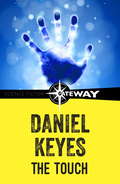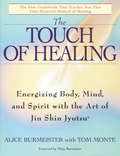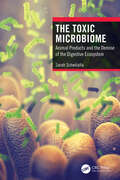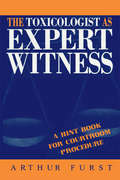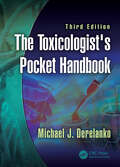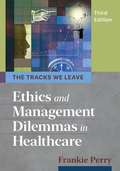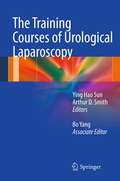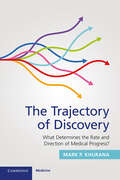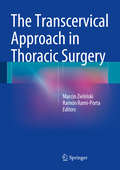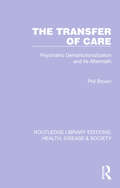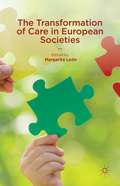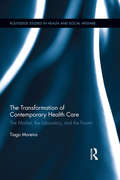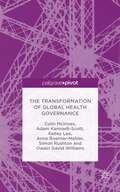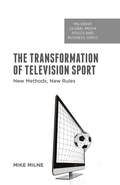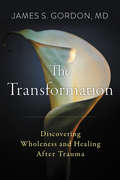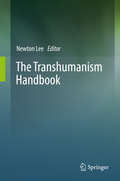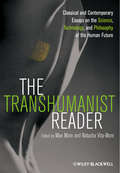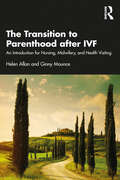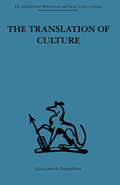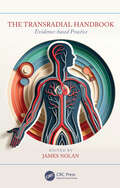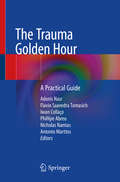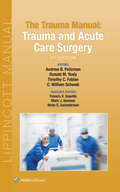- Table View
- List View
The Touch
by Daniel KeyesThe ultimate 'what if' novel, from the million-copy-bestselling author of FLOWERS FOR ALGERNON: 'A masterpiece of poignant brilliance ... heartbreaking' GuardianKaren and Barney Stark should never have married. Childless, uncomfortable and incompatible, their marriage has not been a success, and the lack of a child only makes the tension between them worse. And living their lives to the beat of a fertility clock only adds to the increasingly volatile atmosphere.When an incident at Barney's workplace causes them both to be unknowingly contaminated with radioactive dust, they also become pariahs - in their neighbourhood and with their families. But things are only going to get worse. Karen discovers she is pregnant and as their closest friends become frightened enemies, the dream of becoming parents turns into a nightmare...
The Touch of Healing
by Alice BurmeisterThe Touch of Healing offers readers the means to greater health, vitality, and self-understanding through the practice of an ancient oriental healing art and practical holistic philosophy called Jin Shin Jystsu. Gentle touching similar to acupressure is used to release tension that accumulates and is at the root of dysfunction, disease, and imbalance. The authors explain the natural life force that runs through the body and demonstrate with case studies, detailed analysis, and more than 30 illustrations, how to integrate this system into one's life. The key healing points and body flows, known as "Safety Energy Locks," are presented with step-by-step instructions on how to utilize them for healing and greater self-awareness. Many self-help practices are also offered that address a wide array of common ailments, including headaches, digestive disorders, fatigue, depression, and arthritis along with prescriptive exercises for relief of emotional ailments such as loss of confidence, anxiety, and depression.
The Toxic Microbiome: Animal Products and the Demise of the Digestive Ecosystem
by Sarah SchwitallaGut microbiomes are dynamic communities varying from population to population and throughout life. In Western societies, a toxic metabolic shift of gut microbiomes is a driver and underestimated risk factor for the development of many noncommunicable chronic pathologies. This book identifies the root cause of these deleterious microbial changes. During the last several decades, increased consumption of animal products, coinciding and correlating with global climate change, has been a contributing cause of undesirable gut microbiome changes.Key Features Establishes a connection between poor gut microbiome health and chronic disease and cancer development Demonstrates how animal products and low-fiber diet patterns induce a detrimental metabolic transition of the gut microbiome from a human health-maintaining towards a disease-promoting state Discusses the opportunity of a toxic microbial metabolic signature as a powerful clinical and diagnostic tool to effectively predict chronic disease and cancer development Provides the latest evidence on different strategies to rebuild a healthy microbiome metabolism and effectively prevent noncommunicable diseases and colorectal cancer Documents the gut microbiome benefits of a plant-based diet
The Toxicant Induction of Irritant Asthma, Rhinitis, and Related Conditions
by William J. MeggsUntoward reactions to environmental chemicals, particularly when a subject reports difficulties with exposures to chemicals of diverse classes involving more than one organ system, have been poorly understood and an area of great controversy. Studies of airway inflammation induced by respiratory irritants have established neurogenic inflammation as the mechanism for irritant asthma and rhinitis. Remodeling of the airway after an acute irritant exposure can lead to a heightened sensitivity to irritants that persists. Recognition that rhinitis, while sometimes regarded as a trivial disease, is associated with extra-airway manifestations such as fatigue and disturbances of sleep, mood, and cognition, further elucidates how chemical exposures can be serious for susceptible individuals. This book reviews current scientific understanding of irritant airway inflammation and related conditions, including cardiovascular effects of particulate exposures, airborne contact dermatitis and irritant dermatitis, and the brain as a target organ for both allergic and irritant reactions. It is essential reading for physicians and other healthcare workers caring for patients with environmental intolerances. Allergists, toxicologists, occupational and environmental physicians, and pulmonologists will find the materials particularly valuable. Patients and advocates for those with chemical intolerances will also find the book of interest.
The Toxicologist as Expert Witness: A Hint Book for Courtroom Procedure
by Arthur FurstAs the world becomes more complex, a greater percentage of the present litigation is based upon very technical subjects. More and more chemicals are being introduced into our daily lives, without ever having been tested for possible side-effects. Consequently, product liability is increasing, and more and more often the toxicologist is being called
The Toxicologist's Pocket Handbook
by Michael DerelankoThe third edition of the Toxicologist’s Pocket Handbook, like the first two editions, is a scaled-down version of the best-selling Handbook of Toxicology. It provides the most frequently used toxicology reference information in a convenient pocket-sized book. The format remains the same as the earlier editions to allow basic reference information to be located quickly, with the information placed in sections specific to subspecialties of toxicology. A detailed table of contents lists all tables and figures contained in the book by section. This expanded edition contains a number of tables not found in the second edition added to sections on lab animals, general toxicology, dermal and ocular toxicology, genetic toxicology/carcinogenesis, neurotoxicology, immunotoxicology, reproductive/developmental toxicology, industrial chemical, and pharmaceutical toxicology. New information is presented for additional laboratory animals such as swine and primates, infusion recommendations, newer methods such as the local lymph node assay, and reference safety pharmacology values for standard species. Additional information on typical genetic toxicology and immunotoxicology assays as well as in vitro assays for eye irritation are provided. Some tables from the second edition have been updated to include new information that has arisen since the earlier edition went to press. Information from the second edition, such as regulatory requirements that are no longer applicable, has been deleted.
The Toxicology of Carbon Nanotubes
by Ken Donaldson Rodger Duffin James Bonner Craig A. PolandThe widespread and increasing use of carbon nanotubes in scientific and engineering research and their incorporation into manufactured goods has urged an assessment of the risks and hazards associated with exposure to them. The field of nanotoxicology studies the toxicology of nanoparticles such as carbon nanotubes and has become a major growth area aimed towards risk assessment of nanoparticles. Compiled by a team of leading experts at the forefront of research, this is the first book dedicated to the toxicology of carbon nanotubes. It provides state-of-the-science information on how and why they are so potentially dangerous if breathed in, including their similarities to asbestos. The book examines various aspects of carbon nanotubes, from their manufacture and aerodynamic behaviour to their effects at molecular level in the lungs. It is invaluable to the many groups involved with research in this area, as well as to regulators and risk assessors.
The Tracks We Leave: Ethics and Management Dilemmas in Healthcare
by Frankie PerryThrough a series of essays and cases based on real-life experiences, this book explores the inter relatedness of ethics and management and helps healthcare professionals at all levels of an organization overcome barriers to ethical decisions.
The Training Courses of Urological Laparoscopy
by Arthur D. Smith Ying Hao Sun Bo YangThe Training Courses of Urological Laparoscopy is written by an international team of experts who have come together to share their experiences of training and skills acquisition in Urological Laparoscopy. Skills training and certification are needed to protect both patient and doctor from the pitfalls of uncertified practice. This comprehensive text focuses on the details of laparoscopic training within the field of urology from step-by-step guidance on the use of basic stems in the dry lab through to hints and tricks for problem solving in more complex scenarios. The Training Courses of Urological Laparoscopy is an essential text for Urologists and residents in training.
The Trajectory of Discovery: What Determines the Rate and Direction of Medical Progress?
by Mark P. KhuranaMedical research works in trajectories. Scientists and researchers must choose to pursue certain scientific pathways and omit others, limited by resources, attention, and time. The trajectory of medical progress is therefore characterized by two crucial characteristics: rate and direction. These two components form the foundation for this book - what are the forces that determine the rate and direction of progress in medicine? This book brings together the worlds of scientific policy, economics, sociology, philosophy, and innovation to describe why the world of medical research looks the way it does. The book also addresses fundamental contemporary issues in medicine, how they influence progress, and how we might improve medical research going forward. The contemporary issues discussed include: flawed incentive structures, a concentration of power and resources among few actors and disease groups, the potential distortionary effects of lobbying by different scientific actors, and missing novelty in drug development.
The Transcervical Approach in Thoracic Surgery
by Marcin Zieliński Ramón Rami-PortaUse of the transcervical approach in thoracic surgery has advanced significantly during the past 60 years, owing primarily to advances in technology. Nevertheless, the possibilities of this approach have never been compiled in a systematic way. This book aims to rectify the situation by describing, in a structured way, all the thoracic procedures that can be performed using the transcervical approach. Indications and contraindications, surgical techniques, complications, and results are all covered, based on the authors' experience and published reports. The contents encompass diverse surgical endoscopic procedures for diagnosis and staging, use of the transcervical approach for surgery to the thymus and mediastinum, lungs and bronchi, trachea and esophagus and miscellaneous items including the role of robotic surgery.
The Transfer
by M. HermassiThis manuscript is a futuristic theory based on a mind, and scientific data, Today is fiction, who knows, tomorrow it may be feasible To all those who do not put barriers to scientific research. Who are we? What are our capacities, our powers, and our limits. The most eminent scholars will say to you: We know little about these questions. All the more reason to look all over the place. This theory, which you will discover while leafing through this little book, opens a door to these questions; especially on our powers. Only one recommendation from the author. If you are conservative in mind, choose another read. On the other hand, if you are curious and free, you will have plenty of questions to ask: the first is: "what if it was possible?"
The Transfer of Care: Psychiatric Deinstitutionalization and Its Aftermath (Routledge Library Editions: Health, Disease and Society #7)
by Phil BrownOriginally published in 1985, this book provides a comprehensive analysis of mental health policy and practice in the USA during the latter part of the 20th Century by focussing on 3 main themes: political-economic structures, the pitfalls of professionalism and institutional obstacles to adequate care.
The Transformation of Care in European Societies
by Margarita LeónThis book aims to explore the nature and extent of the 'care deficit' problem in European societies and how effective the different care systems are in dealing with these problems through policy innovation. It combines theoretical and conceptual debates, cross-national comparisons and analytically-driven case studies.
The Transformation of Contemporary Health Care: The Market, the Laboratory, and the Forum (Routledge Studies in Health and Social Welfare #8)
by Tiago MoreiraThe past three decades have seen enormous changes in the organisation of health care. This book explores the role of knowledge production and technology on these transformations, focusing on the market (attempts to embed principles of economic rationality and efficient use of resources in the shaping and delivery of health care), the laboratory (science, experiments and 'evidence' in the management of research, practice and policy) and the forum (the application of deliberative procedures and other forms of public consultation to health care decision making).
The Transformation of Global Health Governance
by Colin Mcinnes Kelley Lee Simon Rushton Owain David Williams Adam Kamradt-Scott Anne Roemer-MahlerThe authors examine how health governance is being transformed amid globalization, characterized by the emergence of new actors and institutions, and the interplay of competing ideas about global health. They explore how this has affected the governance of specific health issues and how it relates to global governance more broadly.
The Transformation of Television Sport: New Methods, New Rules (Palgrave Global Media Policy and Business)
by M. MilneThe Transformation of Television Sport: New Methods, New Rules examines how developments in technology, broadcasting rights and regulation combine to determine what sport we see on television, where we can see it and what the final output looks and sounds like.
The Transformation: Discovering Wholeness and Healing After Trauma
by James S. Gordon M.D.A world-recognized authority and acclaimed mind-body medicine pioneer presents the first evidence-based program to reverse the psychological and biological damage caused by trauma.In his role as the founder and director of The Center for Mind-Body Medicine (CMBM), the worlds largest and most effective program for healing population-wide trauma, Harvard-trained psychiatrist James Gordon has taught a curriculum that has alleviated trauma to populations as diverse as refugees and survivors of war in Bosnia, Kosovo, Israel, Gaza, and Syria, as well as Native Americans on the Pine Ridge Reservation in South Dakota, New York city firefighters and their families, and members of the U. S. military. Dr. Gordon and his team have also used their work to help middle class professionals, stay-at-home mothers, inner city children of color, White House officials, medical students, and people struggling with severe emotional and physical illnesses. The Transformation represents the culmination of Dr. Gordon’s fifty years as a mind-body medicine pioneer and an advocate of integrative approaches to overcoming psychological trauma and stress. Offering inspirational stories, eye-opening research, and innovative prescriptive support, The Transformation makes accessible for the first time the methods that Dr. Gordon—with the help of his faculty of 160, and 6,000 trained clinicians, educators, and community leaders—has developed and used to relieve the suffering of hundreds of thousands of adults and children around the world.
The Transhumanism Handbook
by Newton LeeModern humanity with some 5,000 years of recorded history has been experiencing growing pains, with no end in sight. It is high time for humanity to grow up and to transcend itself by embracing transhumanism. Transhumanism offers the most inclusive ideology for all ethnicities and races, the religious and the atheists, conservatives and liberals, the young and the old regardless of socioeconomic status, gender identity, or any other individual qualities. This book expounds on contemporary views and practical advice from more than 70 transhumanists. Astronaut Neil Armstrong said on the Apollo 11 moon landing in 1969, “One small step for a man, one giant leap for mankind.” Transhumanism is the next logical step in the evolution of humankind, and it is the existential solution to the long-term survival of the human race.
The Transhumanist Reader: Classical and Contemporary Essays on the Science, Technology, and Philosophy of the Human Future
by Max More Natasha Vita-MoreThe first authoritative and comprehensive survey of the origins and current state of transhumanist thinking The rapid pace of emerging technologies is playing an increasingly important role in overcoming fundamental human limitations. Featuring core writings by seminal thinkers in the speculative possibilities of the posthuman condition, essays address key philosophical arguments for and against human enhancement, explore the inevitability of life extension, and consider possible solutions to the growing issues of social and ethical implications and concerns. Edited by the internationally acclaimed founders of the philosophy and social movement of transhumanism, The Transhumanist Reader is an indispensable guide to our current state of knowledge of the quest to expand the frontiers of human nature.
The Transition to Parenthood after IVF: An Introduction for Nursing, Midwifery and Health Visiting
by Helen Allan Ginny MounceThis book explores how experiences of IVF can affect the transition to parenthood for non-donor infertile couples. Drawing on empirical research and the broader social sciences literature, the book sets out the context of complex modern family building and discusses how infertility and IVF continue to shape parenthood and family building after successful IVF conception. It looks at how stigma, disclosure, loss, and gender affect the transition to parenthood, as well as what happens when parents start thinking about trying for siblings. We highlight the key roles for health care professionals (nurses, midwives, and health visitors) when caring for these new parents, in providing social support and facilitating good communication to foster emotional well-being. Ideal for nurses and midwives working in reproductive health as well as primary care nurses and health visitors, this applied text is a key reference for all healthcare professionals who meet people at any point on their journey to achieving pregnancy through IVF, during maternity care, and through the first few years of parenthood.
The Translation of Culture: Essays to E E Evans-Pritchard (International Behavioural And Social Sciences Ser. #Vol. 2)
by T. O. BeidelmanTavistock Press was established as a co-operative venture between the Tavistock Institute and Routledge & Kegan Paul (RKP) in the 1950s to produce a series of major contributions across the social sciences. This volume is part of a 2001 reissue of a selection of those important works which have since gone out of print, or are difficult to locate. Published by Routledge, 112 volumes in total are being brought together under the name The International Behavioural and Social Sciences Library: Classics from the Tavistock Press. Reproduced here in facsimile, this volume was originally published in 1971 and is available individually. The collection is also available in a number of themed mini-sets of between 5 and 13 volumes, or as a complete collection.
The Transradial Handbook: Evidence-based Practice
by James Nolan Thomas Johnson Karim RatibAccess site techniques for invasive cardiology and interventional radiology procedures have undergone rapidly evolving technological advances, with radial access offering important benefits for patients and health-care systems. This book provides a concise practical guide to the practice of transradial procedures in both specialties. It is a readily accessible source of information that provides evidence-based guidelines from extensive global literature, interpreted and contextualised by experienced and recognised international opinion leaders. It provides an overview of relevant trial data, cannulation technique, catheter selection and manipulation, catheter delivery, right heart catheterisation, and complication management. It offers a comprehensive but portable reference to aid learning for cardiology and radiology professionals and trainees.Key Features: Fills a current gap in a growing transradial market with a contemporary approach Guides cardiology and radiology practitioners and other health-care professionals in optimal performance of transradial access procedures Draws from the experience of world experts, providing a ready reference pocketbook for easy access
The Trauma Golden Hour: A Practical Guide
by Adonis Nasr Flavio Saavedra Tomasich Iwan Collaço Phillipe Abreu Nicholas Namias Antonio MarttosThe Golden Hour is a well-established concept in emergency medicine, related to the critical period of one hour after an injury, accident or trauma. This term implies that the mortality rates increase substantially if efficient care is not provided within 60 minutes after the trauma. This book is intended as a practical manual in Trauma Care within the context of the golden hour, addressing all trauma types and all body parts. Readers will find essential decision-making algorithms and protocols with commentary for traumas, along with easily accessible information on how to treat patients in a very practical and handy fashion. Furthermore, the content is presented in a didactic way suitable for a wide audience, from medical students who want to learn about the basics of trauma care to experienced surgeons seeking a comprehensive guide to trauma-related interventions.The book combines contributions from experts at two renowned Trauma Centers, the Hospital do Trabalhador at Curitiba, Brazil, and the Ryder Trauma Center in Miami, USA. Therefore, considering the different local environments and resources, the book provides distinct perspectives for several injuries, presenting the state of the art in Trauma Care. The diversity of perspectives in this book contributes to a global health care approach suitable for trauma-related events from developed countries to remote areas. The Trauma Golden Hour – A Practical Guide celebrates the Centennial Anniversary of the Federal University of Parana (Brazil), the 25th Anniversary of the Ryder Trauma Center (USA) and the 20th Anniversary of the Hospital do Trabalhador (Brazil).
The Trauma Manual: Trauma and Acute Care Surgery (Spiral Manual Ser.)
by Andrew B. PeitzmanCovering all areas of trauma, critical care, and emergency surgery, The Trauma Manual: Trauma and Acute Care Surgery, 5th Edition, brings you fully up to date with recent changes in the field. This pocket manual is an indispensable resource for everyone on the trauma/acute care team, with practical, easy-to-read coverage of the wide range of patients seen daily with urgent presentation – whether from injury, emergency general surgical disease, or a major complication. This user-friendly manual is one that every trauma surgeon, surgical resident, surgical critical care specialist, emergency medicine physician, and emergency or trauma nurse will want to keep close at hand for daily use.
